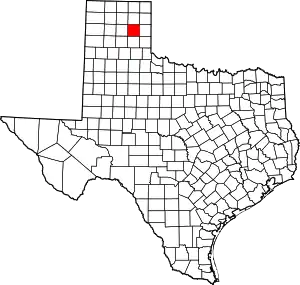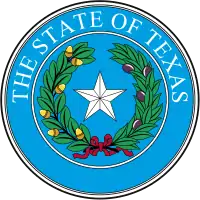Gray County, Texas
Gray County is a county located in the U.S. state of Texas. As of the 2010 census, its population was 22,535.[1] The county seat is Pampa.[2] The county was created in 1876 and later organized in 1902.[3] is named for Peter W. Gray,[4] a Confederate lawyer and soldier in the American Civil War.
Gray County | |
|---|---|
.JPG.webp) The Gray County Courthouse | |
 Location within the U.S. state of Texas | |
 Texas's location within the U.S. | |
| Coordinates: 35°25′N 100°49′W | |
| Country | |
| State | |
| Founded | 1902 |
| Named for | Peter W. Gray |
| Seat | Pampa |
| Largest city | Pampa |
| Area | |
| • Total | 929 sq mi (2,410 km2) |
| • Land | 926 sq mi (2,400 km2) |
| • Water | 3.4 sq mi (9 km2) 0.4%% |
| Population (2010) | |
| • Total | 22,535 |
| • Density | 24/sq mi (9/km2) |
| Time zone | UTC−6 (Central) |
| • Summer (DST) | UTC−5 (CDT) |
| Congressional district | 13th |
| Website | www |
Gray County comprises the Pampa, TX micropolitan statistical area.
Gray County was the center of the White Deer Lands Management Company, which ceased operations in 1957. The history of the company is the theme of the White Deer Land Museum in Pampa, but company archives are at the Panhandle-Plains Historical Museum in Canyon. Timothy Dwight Hobart, the White Deer land agent from 1903 to 1924, was elected mayor of Pampa in 1927.
The Clinton-Oklahoma-Western Railroad Company of Texas served Gray County with service to Hemphill County at the Oklahoma border. Another line then connected eastward to Clinton, Oklahoma. An 11-mile extension of the COW-T ran from rural Heaton to the former oil camp of Coltexo in Gray County.[5] Originally a Frank Kell property, the COW-T was acquired in 1928 by the Atchison, Topeka and Santa Fe Railway, which then leased it in 1931 to the former Panhandle and Santa Fe Railway.[6]
Geography
According to the U.S. Census Bureau, the county has a total area of 929 square miles (2,410 km2), of which 926 sq mi (2,400 km2) are land and 3.4 sq mi (8.8 km2) (0.4%) are covered by water.[7]
Major highways
.svg.png.webp) Interstate 40
Interstate 40 U.S. Highway 60
U.S. Highway 60 State Highway 70
State Highway 70 State Highway 152
State Highway 152 State Highway 273
State Highway 273
Adjacent counties
- Roberts County (north)
- Wheeler County (east)
- Donley County (south)
- Carson County (west)
- Hemphill County (northeast)
- Hutchinson County (northwest)
- Collingsworth County (southeast)
National protected area
Demographics
| Historical population | |||
|---|---|---|---|
| Census | Pop. | %± | |
| 1880 | 56 | — | |
| 1890 | 203 | 262.5% | |
| 1900 | 480 | 136.5% | |
| 1910 | 3,405 | 609.4% | |
| 1920 | 4,663 | 36.9% | |
| 1930 | 22,090 | 373.7% | |
| 1940 | 23,911 | 8.2% | |
| 1950 | 24,728 | 3.4% | |
| 1960 | 31,535 | 27.5% | |
| 1970 | 26,949 | −14.5% | |
| 1980 | 26,386 | −2.1% | |
| 1990 | 23,967 | −9.2% | |
| 2000 | 22,744 | −5.1% | |
| 2010 | 22,535 | −0.9% | |
| 2019 (est.) | 21,886 | [8] | −2.9% |
| U.S. Decennial Census[9] 1850–2010[10] 2010–2014[1] | |||
As of the census[11] of 2000, 22,744 people, 8,793 households, and 6,049 families were residing in the county. The population density was 24 people per square mile (9/km2). The 10,567 housing units averaged 11 per mi2 (4/km2). The racial makeup of the county was 82.15% White, 5.85% African American, 0.94% Native American, 0.39% Asian, 8.25% from other races, and 2.42% from two or more races. About 13.01% of the population was Hispanic or Latino of any race.
Of the 8,793 households, 30.00% had children under the age of 18 living with them, 57.00% were married couples living together, 9.00% had a female householder with no husband present, and 31.20% were not families. About 28.70% of all households were made up of individuals, and 15.30% had someone living alone who was 65 years of age or older. The average household size was 2.39, and the average family size was 2.93.
In the county, the age distribution was 24.00% under 18, 8.40% from 18 to 24, 27.20% from 25 to 44, 22.30% from 45 to 64, and 18.10% who were 65 or older. The median age was 39 years. For every 100 females, there were 104.00 males. For every 100 females age 18 and over, there were 103.70 males.
The median income for a household in the county was $31,368, and for a family was $40,019. Males had a median income of $32,401 versus $20,158 for females. The per capita income for the county was $16,702. About 11.20% of families and 13.80% of the population were below the poverty line, including 17.60% of those under age 18 and 9.60% of those age 65 or over.
Politics
Prior to 1952, Gray County was primarily Democratic similar to most of Texas and the Solid South. The county only gave a Republican presidential candidate a majority before 1952 in 1928, when Herbert Hoover won the county due to anti-Catholic sentiment towards Al Smith. Starting with the 1952 election, the county has become a Republican stronghold along with the rest of the Texas Panhandle. This level of Republican dominance has increased in recent years, as every Republican presidential candidate in the second millennium has racked up 80% of the county's vote. Additionally, in the two most recent presidential elections, Democrats Barack Obama and Hillary Clinton have failed to win even 1,000 votes total in the county.
| Year | Republican | Democratic | Third parties |
|---|---|---|---|
| 2020 | 87.9% 6,812 | 10.6% 820 | 1.5% 113 |
| 2016 | 87.8% 6,500 | 9.5% 701 | 2.8% 204 |
| 2012 | 87.2% 6,443 | 12.0% 886 | 0.8% 60 |
| 2008 | 85.1% 6,924 | 14.2% 1,153 | 0.7% 56 |
| 2004 | 84.7% 7,260 | 15.0% 1,289 | 0.3% 23 |
| 2000 | 82.3% 6,732 | 16.8% 1,376 | 0.9% 77 |
| 1996 | 69.2% 6,102 | 24.0% 2,114 | 6.9% 608 |
| 1992 | 58.9% 6,105 | 23.4% 2,426 | 17.8% 1,841 |
| 1988 | 74.2% 7,259 | 25.2% 2,460 | 0.6% 62 |
| 1984 | 81.5% 8,955 | 18.2% 2,003 | 0.3% 30 |
| 1980 | 70.8% 7,187 | 27.5% 2,786 | 1.7% 176 |
| 1976 | 60.3% 6,010 | 38.9% 3,872 | 0.8% 80 |
| 1972 | 84.4% 7,968 | 14.5% 1,367 | 1.2% 109 |
| 1968 | 55.5% 5,994 | 22.0% 2,374 | 22.5% 2,427 |
| 1964 | 57.9% 5,011 | 42.0% 3,633 | 0.1% 6 |
| 1960 | 68.8% 6,197 | 31.1% 2,802 | 0.2% 14 |
| 1956 | 61.9% 5,047 | 37.2% 3,034 | 0.9% 72 |
| 1952 | 61.7% 5,467 | 38.0% 3,367 | 0.3% 23 |
| 1948 | 28.0% 1,594 | 64.9% 3,699 | 7.1% 403 |
| 1944 | 34.9% 1,739 | 61.5% 3,067 | 3.7% 183 |
| 1940 | 22.0% 1,217 | 77.9% 4,315 | 0.1% 8 |
| 1936 | 9.6% 464 | 89.8% 4,347 | 0.6% 28 |
| 1932 | 12.7% 505 | 86.7% 3,446 | 0.6% 24 |
| 1928 | 65.4% 1,871 | 34.4% 986 | 0.2% 6 |
| 1924 | 48.9% 581 | 51.1% 608 | |
| 1920 | 31.0% 251 | 65.2% 529 | 3.8% 31 |
| 1916 | 11.7% 69 | 82.0% 482 | 6.3% 37 |
| 1912 | 3.1% 13 | 64.6% 272 | 32.3% 136 |
Notable people
- Phil Cates, state representative from 1971 to 1979, was born in Pampa in 1947.[13]
- Tom Mechler, state Republican Party chairman since 2015, is a former Gray County Republican chairman.
- Kae T. Patrick, a native of Gray County, served in the Texas House of Representatives from San Antonio from 1981 to 1988.
See also
References
- "State & County QuickFacts". United States Census Bureau. Archived from the original on October 18, 2011. Retrieved December 16, 2013.
- "Find a County". National Association of Counties. Archived from the original on 2011-05-31. Retrieved 2011-06-07.
- "Texas: Individual County Chronologies". Texas Atlas of Historical County Boundaries. The Newberry Library. 2008. Retrieved May 23, 2015.
- Gannett, Henry (1905). The Origin of Certain Place Names in the United States. Govt. Print. Off. pp. 142.
- "Coltexo, Texas". tshaonline.org. Retrieved April 27, 2013.
- "Clinton-Oklahoma-Western Railroad". tshaonline.org. Retrieved April 27, 2013.
- "2010 Census Gazetteer Files". United States Census Bureau. August 22, 2012. Retrieved April 27, 2015.
- "Population and Housing Unit Estimates". United States Census Bureau. May 24, 2020. Retrieved May 27, 2020.
- "U.S. Decennial Census". United States Census Bureau. Retrieved April 27, 2015.
- "Texas Almanac: Population History of Counties from 1850–2010" (PDF). Texas Almanac. Retrieved April 27, 2015.
- "U.S. Census website". United States Census Bureau. Retrieved 2011-05-14.
- Leip, David. "Dave Leip's Atlas of U.S. Presidential Elections". uselectionatlas.org. Retrieved 10 April 2018.
- "Phil Cates". Texas Legislative Reference Library. Retrieved June 29, 2015.
External links
- Gray County government's website
- Gray County from the Handbook of Texas Online
- Gray County Profile from the Texas Association of Counties
| Wikimedia Commons has media related to Gray County, Texas. |
